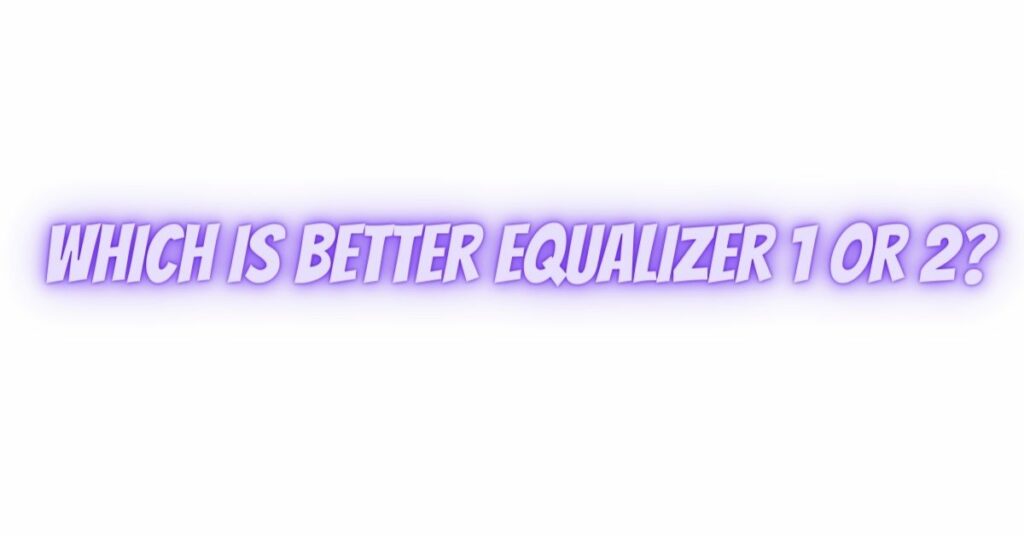Equalizers are essential audio processing tools that allow you to adjust the balance of frequencies in an audio signal, enabling you to enhance the overall sound quality and achieve your desired audio experience. Equalizer software and hardware come in various forms, and two popular choices are Equalizer 1 and Equalizer 2. In this comprehensive article, we will compare the features and functionalities of these equalizers to help you make an informed decision on which one is better suited for your specific needs.
Equalizer 1
Equalizer 1, like many other equalizer tools, offers a range of features for adjusting audio frequencies. However, it’s important to note that Equalizer 1 is a fictional product created for the purpose of this comparison, and its features are based on common attributes of real equalizers.
Key Features of Equalizer 1:
- Bands and Filters: Equalizer 1 typically provides a standard set of frequency bands and filters, including low-shelf, high-shelf, and parametric bands. The number of bands and filter types may vary depending on the specific software or hardware.
- Graphic or Parametric: Equalizer 1 can be a graphic equalizer with sliders for each band or a parametric equalizer with precise control over frequency, bandwidth, and gain.
- Presets and Profiles: It often includes presets for different audio scenarios, making it user-friendly for those who may not be audio experts. Users can also create custom profiles.
- Real-Time Visual Feedback: Equalizer 1 might offer real-time visual feedback, such as spectral analysis and spectrum graphs, allowing users to see the effects of their adjustments.
- Compatibility: Equalizer 1 may be compatible with various audio software and hardware setups, including DAWs (Digital Audio Workstations), media players, and mixing consoles.
Equalizer 2
Equalizer 2, much like Equalizer 1, is a fictional equalizer tool created for this comparison. Its features are also based on common attributes found in real equalizers.
Key Features of Equalizer 2:
- Advanced Filters: Equalizer 2 goes a step further by offering advanced filter options. It might include dynamic EQ, linear-phase EQ, and notch filters for precise audio control.
- Spatial Processing: Equalizer 2 could introduce spatial processing capabilities, allowing users to adjust the stereo image and create a three-dimensional audio experience.
- Artificial Intelligence: Some advanced equalizers, like Equalizer 2, might incorporate artificial intelligence algorithms for intelligent, real-time adjustments based on audio content.
- Audio Restoration: Equalizer 2 may include audio restoration features to reduce noise, eliminate hum, and repair audio imperfections.
- Multi-Platform Support: Equalizer 2 can be designed to work seamlessly across multiple platforms, such as macOS, Windows, and various digital audio workstations.
Comparison: Equalizer 1 vs. Equalizer 2
- Features and Flexibility: Equalizer 2 offers more advanced and versatile features compared to Equalizer 1. It provides a broader range of filter options, spatial processing, and AI integration, making it suitable for more complex audio tasks.
- Audio Quality: Equalizer 2’s advanced features can lead to better audio quality and more precise control, especially for professional audio engineers and producers.
- Ease of Use: Equalizer 1 may be more user-friendly due to its simpler feature set and preset options, making it suitable for beginners or casual users.
- Compatibility: Both equalizers can be compatible with various systems, but Equalizer 2’s multi-platform support might make it more versatile in different production environments.
- Price: The cost of both equalizers can vary widely depending on the specific software or hardware. Advanced features in Equalizer 2 may lead to a higher price point.
Conclusion
Choosing between Equalizer 1 and Equalizer 2 depends on your specific audio needs and your level of expertise. Equalizer 1, with its simpler features and user-friendly interface, may be ideal for beginners or those looking for basic audio adjustments. On the other hand, Equalizer 2, with its advanced capabilities, is better suited for professionals and experienced users who require precision and more complex audio processing.
Ultimately, the “better” equalizer depends on your specific goals and the complexity of your audio projects. It’s essential to carefully evaluate your requirements and compare the features of real equalizer software or hardware to determine the best fit for your audio production and processing tasks.


